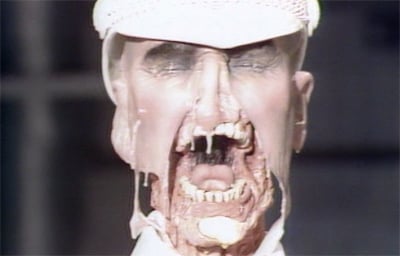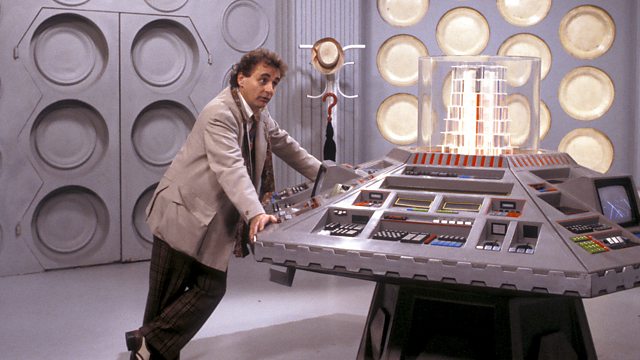Dragonfire
“Ice Ice Baby. Ice Ice Baby.”
Immediately before the transmission of its first episode, BBC1 announced that Dragonfire was “the 150th adventure” for Doctor Who. If you don’t believe me, you can watch that announcement here. Whether it was (or wasn’t) is, amazingly, still a matter of some dispute in fandom. As ever with Doctor Who, there are a number of ways to count, and to decide what counts - and yet by just about any counting method you prefer to use, Doctor Who managed to double that number by passing its 300th adventure at some point in the last year or so.
This means that Dragonfire, fewer than ten stories from the end of the show’s twentieth century run, is now more or less the mid-point of Doctor Who. There are around a hundred and fifty Doctor Who TV stories before it, and around a hundred and fifty stories Doctor Who TV stories after it. When it was made, the series’ midpoint was its seventy fifth serial, Robot, Tom Baker’s debut from 1974/5. Almost thirteen years after Robot, no one would have risked money on betting that there would be as much television Doctor Who after 1987 as before it.
The series’ brief cancellation in 1985, and the public disagreements about it that followed, damaged perceptions of the series and occasioned a dramatic fall in the number of people watching Doctor Who when it did return in 1986. The series’ fan base, disenchanted with the programme’s creative direction, but also terrified by the possibility it might be taken away from them, became a reliable source of newspaper copy and items on magazine programmes, many of which concentrated on the paradox of them being fans who seemingly hated a programme they devoted so much of their lives to, but which they insisted must continue despite them hating it.
It was a strange time to be a Doctor Who fan. Although speaking as someone who was part of the pre-teen viewership of the series, it was entirely possible for Doctor Who to be your favourite programme on television (which is as good a definition of “fan” as any) and for you to have no idea that any of this was going on. Because you didn’t read newspapers or watch magazine programmes. Or have any idea what anyone outside your school and immediate family thought about Doctor Who.
This was, of course, in part, because Doctor Who was not actually that big a deal anymore. Maybe five or six kids in my school class of thirty watched it. All boys. Although three or four of us were very keen. The sort of keen who’d wind up going to fan events in the 1990s, although as far as I know, I’m the only one who became an actual lifer.
That first episode of Dragonfire was transmitted on Doctor Who’s twenty fourth anniversary, the first time a new episode had actually gone out on the show’s birthday since 1968. This aspect wasn’t celebrated by BBC One. Not least, I’m sure, because twenty fourth anniversaries aren’t really a thing but, at least according to Sophie Aldred who made her debut in the episode, more had been planned and a Blue Peter feature celebrating both milestones, and introducing her to the audience was cancelled at the last minute.
A cynic might observe that while Blue Peter had long been a notable friend to Doctor Who within the BBC, that relationship had in part depended on it being mutually beneficial, and by 1987 there was little benefit in being associated with Doctor Who, it being a series that, as far as we can tell, was largely still made because BBC Drama anticipated another tabloid scandal should it end, rather than because of anyone in BBC Drama had a strong desire to make it.
Anyone that is, except the series’ recently appointed Script Editor Andrew Cartmel, who saw Doctor Who as a massive oppurtunity and was just getting started. He had planned with Delta and the Bannermen’s writer Malcolm Kohll and Dragonfire’s author Ian Briggs, both writers whose work he had encountered while reading specs at the BBC Script Unit, that one of them would write a more comic story, while the other would be responsible for a more serious one. Briggs volunteered to write the comedy, and early drafts of his story had the villain as a teenage financial whiz kid with an obsequious sidekick called Mister Spewy.
Despite this, you would be hard pressed to argue that Dragonfire is not played straighter than not only Delta and the Bannermen but also Paradise Towers and Time and the Rani. Sure, it’s often silly, and it has tonal and production misfires. But overall it is harder edged than the previous three stories, with a memorably sinister score. Onscreen the boy genius and Mister Spewey are nowhere to be seen, and there is a completely different, and absolutely superb, villain in Edward Peel’s vengeance-obsessed heat vampire Kane. An exiled criminal and wannabe dictator.
Peel, at the time well known on television as the harried Chief Inspector in Police drama Juliet Bravo relishes the opportunity to play something completely different, and while the idea of playing someone said to have a body temperature of minus 193 celsius as cold is an obvious one, it works perfectly. He’s Doctor Who’s most effective new villain for years. He also has a hugely memorable - and remarkably horrific - death scene, in which he commits suicide realising his dreams of revenge have come to nothing, and that the empire he aspired to rule no longer exists. (Peel won Doctor Who Magazine’s Best Villain award for his performance and more than a third of a century later remains thrilled to have done so. I asked him.)
Dragonfire is both eclectic and eccentric, with a huge ragbag of contrasting and conflicting influences. Ace’s real name is Dorothy, and, while it is never said out loud, her surname was intended to be Gale. This (obvious) nod to The Wizard Of Oz is the tip of the iceberg when it comes to film influences and in jokes. The Biomechanoid obviously owes its design to Alien, and the hunt to destroy it derives from that film’s sequel. But the creature is noble, and friendly. Its relationship with a little girl - the missing daughter of a determined shopper - plays out like something from James Whale’s Frankenstein, without the shock ending.

Kane owes his name to Orson Welles’ masterpiece and his death scene to Raiders of the Lost Ark. The script names characters after director Vsevolod Pudovkin, theorists Béla Balázs, Siegfried Kracauer, Rudolph Arnheim, André Bazin and Marshall McLuhan, while at one point a character directly quotes from The Unfolding Text, John Tulloch and Manuel Alvarado’s groundbreaking, if variable, 1983 attempt at an academic study of Doctor Who, and one of the pile of books - along with Alan Moore and Ian Gibson’s Halo Jones - Cartmel asked his newly minted writers to read to see the shape of his idea of the series.
None of this, though, should be taken to indicate that Dragonfire is dry or sterile. Despite its relative darkness and allusions to theory, it’s funny and fun, with traces of that original comic conception (for example in the treatment of characters like the woman so absorbed in her shopping experience she fails to notice a massacre). Fan complaints at the time centred on some comic business with milkshakes and similar moments of silliness. Or them just not noticing what’s going in the cliffhanger to Part One.
Neither, though, is it empty. Supporting characters like Balazs (Patricia Quinn) have stories and lives of their own, which reflect on, yet never take away from, those of the Doctor and his party. Dragonfire reflects the new production office’s determination to simultaneously take Doctor Who seriously and have fun both in and with it. It won the 1987 Doctor Who Magazine and Doctor Who Appreciation Society Best Story Awards handily, and Briggs was asked to write for the series again. The addition of Ace to the programme’s regular cast was instantly regarded as a positive move by just about everyone who retained any interest in Doctor Who.
Sylvester McCoy would later note that while Bonnie Langford was an old friend from his theatre days with whom he loved working, her character had been conceived as a foil for Colin Baker’s Doctor “a wonderful tall actor in a bright coat”, and that Ace, designed as a partner for his own characterisation of Doctor Who, instantly made the series better. That both have returned to television Doctor Who as guest characters this century remains pleasing to this child of the 1980s.
In Dragonfire’s initial scripts Kane was called Hess. Nathan-Turner vetoed this because of the (deliberate) resonance with Rudolf Hess. Hess had been Hitler’s Deputy and by 1987 was the last surviving inmate of Spandau, a prison which had, since the 1940s, been exclusively for Nazi war criminals. Others on the production thought Nathan-Turner over cautious. Then, between Dragonfire’s studio dates and its intended transmission, Hess hanged himself in Spandau’s summer house. His suicide ignited a political and historical controversy which still occasionally resurfaces to this day.
Without the late change Dragonfire, with its villain a suicidal would-be tyrant of the same name, might have been deemed untransmittable, at least temporarily. Or required substantial editing. The rest of the crew decided there was probably something in Nathan-Turner’s instincts after all.
The nature of that creative, but not personal, disagreement, and its resolution reveals something about the engine that was now powering Doctor Who as 1987 ended. The combination of JNT as “seen it all” wise head who knew which battles to fight, and Cartmel’s undergraduate eclecticism, anti-authoritarianism and refusal to contemplate the idea there were arenas in which Doctor Who shouldn’t play. The next two years would show this to be a potent combination and ensure the twentieth century show ended with stories that would have a creative legacy that would be reused and repurposed in the next century. Something that, in the view of this writer at least, would not have been the case had the series ended with Revelation of the Daleks or The Ultimate Foe.
Dragonfire is the mid point of television Doctor Who. But there is another and far more important sense in which it sees the show turning a corner.
